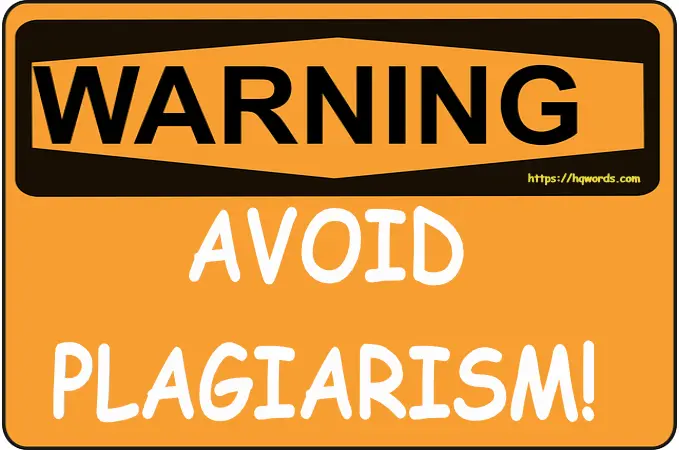What is Plagiarism in Research? (How to Avoid it)
Plagiarism is a serious offense in academic research. Here are some tips on how to avoid plagiarism in research papers. Stay proactive and avoid any retraction chances!
by Nsikak Ekikor.

Plagiarism and Research
Writing a research paper presents difficulties in gathering literature and providing evidence to strengthen your paper.
Drawing on previously established ideas and values and including relevant information in your paper are necessary steps, but they must be taken with caution to avoid plagiarism.
To understand how to avoid plagiarism, it is necessary to first understand the various types of plagiarism.
READ ALSO:
- Daddy’s Little Girl 2 – Letter to Parents
- The Tortoise And The Feast in Heaven
- Why The Tortoise And The Squirrel Are Not Friends
What is Plagiarism in Research?
Plagiarism is the unethical practice of using the words or ideas (whether intentional or unintentional) of another author/researcher or your own previous works without proper attribution.
Plagiarism is a serious academic and intellectual offense that can lead to severe consequences such as paper retractions and loss of author credibility and reputation.
It is a significant issue in academic publishing and a major cause of paper retractions.
As a result, researchers must improve their understanding of plagiarism. Academic traditions and nuances may not require authentication by citing the source of words or ideas in some cultures.
This type of validation, however, is required by the global academic code of conduct.
Non-native English speakers face a greater challenge in communicating technical content in English while also adhering to ethical rules.
Plagiarism is affected by the digital age as well. Researchers have easy access to material and data on the internet, which makes copying and pasting information simply.
Types of plagiarism
In academic writing, there are various types of plagiarism you might encounter:
1. Global Plagiarism
This means plagiarizing an entire text. This includes purchasing an essay or turning in an assignment completed by someone else.
2. Verbatim Plagiarism
It means directly copying someone’s words, without using quotation marks or citing the source.
Paraphrasing plagiarism
This means rephrasing someone else’s ideas and presenting them as if they were your own original thoughts.
3. Patchwork Plagiarism
It means copying phrases, passages, and ideas from different sources and compiling them into a new text.
Although most plagiarism relates to the text, it’s also possible to plagiarize things like images, data, and music. Any time you’re using something someone else created, you must give credit to the source.
Other than global plagiarism, all these types can occur accidentally and deliberately, through a lack of familiarity with how to properly incorporate and cite sources. But even accidental plagiarism can still have serious consequences.

How Can You Avoid Plagiarism in a Research Paper?
Protect yourself from plagiarism, no matter how unintentional. Here are some tips for avoiding plagiarism.
1. Paraphrase your Content
Do not copy and paste the text from the reference paper verbatim. Instead, rephrase the concept in your own words.
Understand the idea(s) of the reference source thoroughly before paraphrasing it, or use an online paraphrasing tool to paraphrase your content effortlessly.
2. Make use of Quotations
Use quotation marks to indicate that the text was taken from another source. The quotes should be exactly as they appear in the paper from which they were taken.
3. Reference your Sources
Determine what needs to be cited and what does not. The best way to avoid plagiarism is to self-check your documents with plagiarism checker tools.
Any words or ideas that are not your own and were borrowed from another paper must be cited.
4. Cite Your Own Works
If you use content from a previous paper, you must cite it. Self-plagiarism is the use of previously published material without citation.
You should not cite the scientific evidence you gathered after conducting your tests.
It is not necessary to cite facts or common knowledge. Include a reference if you are unsure.
5. Keep Track of the Sources you Consult
Keep track of the sources you consult. To manage the citations for the paper, use citation software such as EndNote or Reference Manager.
For the background information/literature survey, use a variety of references. Individual papers, rather than a review, should be referred to, for example.
6. Use Plagiarism Checkers
To determine how much of your paper is plagiarized, use plagiarism detection tools such as iThenticate or HelioBLAST (formerly eTBLAST).
While it is acceptable to review previously published work, it is not acceptable to paraphrase it with significant similarities.
The majority of plagiarism occurs in any document’s literature review section (manuscript, thesis, etc.).
As a result, if you carefully read the original work, try to understand the context, take good notes, and then express it to your target audience in your own language (while citing the original source), you will never be accused of plagiarism (at least for the literature review section).
READ ALSO:
- Song of a Girl Going to Bathe
- Writing Tips To Guide Your Writing Journey
- Life is a Place Where it’s Forbidden to Live
We believe the above piece of information was useful. Please, kindly share this content on all the available social media platforms.
